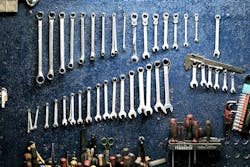Summer Is Ending: How Cool Were You?
There are dozens of puns we can make as we approach the end of summer. If you’re a fan of one popular cable TV show, you know that “winter is coming.” (You might have to Google that one.) Or, we might pull out a moldy chestnut from the marketing textbook of buzzwords to ask: “Did you beat the heat?”
[Insert groan here]
In the autumn and winter months ahead, outdoor laborers in the southeast, southwest and other perpetually warm climates won’t get a break from the heat. If that describes you, the summer risks of dehydration and heat exhaustion will continue to be a daily reality well into fall and winter. Even if it’s not scorching hot, our bodies can overheat when we don’t pay attention.
Furthermore, OSHA requires employers to ensure safe working conditions at all times. This is a good time to reflect on how you think you handled summer. Were all employees adequately cared for? Was there a sudden uptick in heat-related injuries or sicknesses? Did you manage the costs involved in keeping everyone cool, or did you spend a lot more than you think you should? By the way, cost-effective doesn’t mean “How to be a Cheapskate in Just 5 Easy Steps;” it’s knowing how to spend smart while keeping expectations realistic. We’ll break the rest of this article into two sections: caring for employees and being cost effective.
OSHA Mandated Care for Employees
There are three words OSHA wants you to know: water, shade and rest. The vast majority of heat-related illnesses, injuries and deaths can be prevented with an adequate amount of those three things. Plan accordingly, and don’t be afraid to let your people take breaks more frequently than you might think. A minimum of one cup of water should be consumed every 15-20 minutes, avoiding caffeine or soda. If those caffeinated/sugary drinks are consumed, more water may be necessary to prevent rapid dehydration.While veteran employees tend to be better acclimatized to hot weather, be watchful of newcomers. They might need even more water, shade and rest than the others. In fact, the first 14 days of employment are the most dangerous for employees, statistically speaking. Even more specifically, most heat-related deaths occur during the first three days of employment, and one-third of those deaths happen on the very first day of employment. That’s pretty remarkable — and very preventable.
For new and veteran employees alike, be on the lookout for signs of heat illness and dehydration. Anyone who appears or even says they are dizzy, feeling unduly fatigued, nauseous, confused or fainting is at risk. Confusion and fainting are two of the most obvious signs of a medical emergency and should be dealt with seriously.
OSHA also mandates that shaded and/or air-conditioned areas be provided. Workers should have access to these spaces as necessary. The need for cooled-down rest areas raises an important question: how can you keep an outdoor or semi-exposed facility cool without breaking the bank? In many cases, air conditioning is just not feasible, and in every case, it’s expensive. This quagmire brings us to our next point: how to manage costs while you stay safe in the heat.
Keep Costs Down with an Industrial-Strength Swamp Cooler
Portable swamp coolers — sometimes called evaporative air coolers — are not new. Many people in the southwest and western United States already know about them because there’s really no better alternative to air conditioning. They’re extremely cheap to operate (about $1/day to run) and don’t use chemicals or coolants. When put near an open space or window, a large swamp cooler will pull in hot, dry air from outside. Water drips down an evaporative media and evaporates against that hot air. The effect is significantly chilled air that gets blown out by the fan, air that’s up to 26 F cooler than the surrounding air. Holy icicle frost, Batman!Air conditioning is a massive cost, and you should never have to stress over the cost of keeping your space cool just to keep your employees safe. A portable swamp cooler will roll wherever you need it, so if you’re working in different places, you can move the cooler where it will best keep everyone cool. Plug it into one of those OSHA-mandated rest areas, and you’ve got a safe, comfortable space that meets those strict government requirements.
A quick note on arid vs. humid climates: while swamp coolers work best in arid climates, even shop owners in muggy regions can use them outdoors. The cooling effect will be reduced but still more noticeable than standard ceiling or free-standing fans.
However you plan on keeping cool, you need a plan. Do your employees experience preventable heat illnesses and injuries? Don’t risk a lawsuit or further injury. And don’t wait another year to get on board. Follow all of OSHA’s recommendations, as found on www.osha.gov, and remember that swamp coolers can pay for themselves in the first year alone, especially if they’re used to replace air conditioning.
